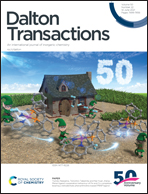Structural and proton conductivity studies of fibrous π-Ti2O(PO4)2·2H2O: application in chitosan-based composite membranes†
Abstract
Although the fibrous polymorphic modification of titanium phosphate, π-Ti2O(PO4)2·2H2O (π-TiP) has been known for decades, its crystal structure has remained unsolved. Herewith, we report the crystal structure of π-TiP at room temperature, as determined from synchrotron radiation powder X-ray diffraction, and corroborated by 31P solid state NMR and accurate density functional theory calculations. In contrast to the previously reported ρ-TiP polymorph, the as-synthesized hydrated phase crystallizes in the monoclinic system (P21/c, a = 5.1121(2) Å, b = 14.4921(9) Å, c = 12.0450(11), β = 115.31(1)°, Z = 4), and is composed of corner-sharing titanium octahedra and phosphate units arranged in a pattern that is unique to the ρ-TiP polymorph. The unit cell was confirmed by electron diffraction, while the formation of planar packing imperfections and stacking faults along the [101] plane was revealed by HRTEM analysis. An in situ dehydration study of π-TiP, monitored by high-temperature powder X-ray diffraction, led to a new anhydrous monoclinic (P21/c, a = 5.1187(13) Å, b = 11.0600(21) Å, c = 14.4556(26), β = 107.65(2)°, Z = 4) phase that crystallizes at 500 °C. The latter resembles the packing fashion of the parental π-TiP, albeit titanium atoms are present in both distorted tetrahedral and octahedral coordination environments. Anhydrous π-TiP was found to partially rehydrate at room temperature, reversibly adopting the structure of the initial phase. The studies carried out under different conditions of leaching and impregnation with H3PO4 showed that π-TiP exhibits an extrinsic proton conductivity (1.3 × 10−3 S cm−1 at 90 °C and 95% RH) due to the presence of the protonated phosphate species bound on the particles surface, as revealed by 31P MAS-NMR spectroscopy data. The composite membranes of Chitosan (CS) matrices filled with H3PO4-impregnated π-TiP solid show an increment of proton conductivity up to 4.5 × 10−3 S cm−1, at 80 °C and 95% RH, which is 1.8-fold higher than those of the bare CS membranes.



 Please wait while we load your content...
Please wait while we load your content...